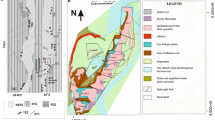Abstract.
Detailed analyses of melt and fluid inclusions combined with an electron-microprobe survey of boron-bearing minerals reveal the evolution of boron in a highly evolved peraluminous granite-pegmatite complex and the associated high- and medium-temperature ore-forming hydrothermal fluids (Ehrenfriedersdorf, Erzgebirge, Germany). Melt inclusions in granite represent embryonic pegmatite-forming melts containing about 10 wt% H2O and 1.8 wt% B2O3. These melts are also enriched in F, P, and other incompatible elements such as Be, Sn, Rb, and Cs. Ongoing differentiation and volatile enrichment drove the system into a solvus, where two pegmatite-forming melts coexisted. The critical point is at about 712 °C, 100 MPa, 20 wt% H2O and 4.1 wt% B2O3. Cooling and concomitant fractional crystallisation from 700 to 500 °C induced development of two conjugate melts, an H2O-poor (A-melt) and an H2O-rich melt (B-melt) along the opening solvus. Boron is a major element in both melts and is preferentially partitioned into the H2O-rich melt. Temperature-dependent distribution coefficients \( D_{{\rm{boron}}}^{{\rm{B - melt/A - melt}}} \) are 1.3 at 650 °C, 1.5 at 600 °C, and 1.8 at 500 °C. In both melts, boron concentrations decreased during cooling because of exsolution of a boron-rich hypersaline brine throughout the pegmatitic stage. Boromuscovite containing up to 8.5 wt% was another sink for boron at this stage. The end of the melt-dominated pegmatitic stage was attained at a solidus temperature of around 490 °C. Fluid inclusions of the hydrothermal stage reveal trapping temperatures of 480 to 370 °C, along with varying densities and highly variable B2O3 contents ranging from 0.20 to 2.94 wt%. A boiling system evolved, indicating a complex interplay between closed- and open-system behaviour. Pressure switched from lithostatic to hydrostatic and back, generating hydrothermal convection cells where meteoric waters were introduced and mixed with magmatic fluids. Boron-rich solutions originated from magmatic fluids, whereas boron-depleted fluids were mainly of meteoric origin. This highlights the potential of boron for discriminating fluids of different origin. Tin is continuously enriched during the evolution because tin and boron are cross-linked by formation of boron-, fluorine- and tin-fluorine-bearing complexes and is finally deposited within quartz-cassiterite veins during the transition from closed- to open-system behaviour. Boron does not only trace the complex evolution of the Ehrenfriedersdorf complex but exerts, together with H2O, F and P, an important control on the physical and chemical properties of pegmatite-forming melts, and particularly on the formation of a two-melt solvus at low pressure. We discuss this with respect to experimental results on H2O solubility and the critical behaviour of the haplogranite-water system which contained variable concentrations of volatiles.
Similar content being viewed by others
Author information
Authors and Affiliations
Additional information
Electronic Publication
Rights and permissions
About this article
Cite this article
Thomas, R., Förster, HJ. & Heinrich, W. The behaviour of boron in a peraluminous granite-pegmatite system and associated hydrothermal solutions: a melt and fluid-inclusion study. Contrib Mineral Petrol 144, 457–472 (2003). https://doi.org/10.1007/s00410-002-0410-5
Received:
Accepted:
Issue Date:
DOI: https://doi.org/10.1007/s00410-002-0410-5




